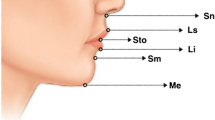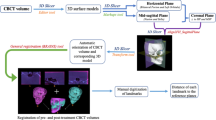Abstract
Background
Assessing facial asymmetry is important to prevent unsatisfactory results in rhinoplasty. There has yet to be a consensus on reference lines for determining asymmetry. This study aimed to determine ideal reference lines to assess facial asymmetry and identify predictors of subjective perceptions of facial asymmetry.
Methods
Preoperative photographs of 47 patients who underwent rhinoplasty were adjusted according to two reference lines (vertical line from the mid-glabella to Cupid’s bow and horizontal interpupillary line). In total, 94 photographs were generated, randomly ordered, and evaluated by two independent observers for anthropometric measurements including six distances (distances from the midline to the medial and lateral canthi, ala, oral commissure, width of midface at maximum distance, and mandible width) and three angles (lateral canthal, lateral alar, and lip margin angles). Photographs were rated by 18 independent observers for subjective perceptions of facial asymmetry.
Results
Observers perceived faces as asymmetric if accompanied by nasal deviation, irrespective of the reference line (p < 0.001). Based on the horizontal reference line, subjective perceptions of asymmetry were correlated with the midline to lateral alar margin distance (r = 0.489, p = 0.003) and sum of the distance ratios (r = 0.354, p = 0.037). None of the objective parameters correlated with subjective perceptions when adopting the vertical reference line. A deviated nose and lateral alar angle were significant predictors of subjective perceptions of facial asymmetry.
Conclusion
To assess facial asymmetry, the horizontal reference line should be determined first followed by the perpendicular vertical line. The nose is the most important feature determining overall facial asymmetry.
Level of Evidence V
"This journal requires that authors assign a level of evidence to each article. For a full description of these Evidence-Based Medicine ratings, please refer to the Table of Contents or the online Instructions to Authors www.springer.com/00266."


Similar content being viewed by others
References
Cheong YW, Lo LJ (2011) Facial asymmetry: etiology, evaluation, and management. Chang Gung Med J 34(4):341–351
Roxbury C, Ishii M, Godoy A, Papel I, Byrne PJ, Boahene KD, Ishii LE (2012) Impact of crooked nose rhinoplasty on observer perceptions of attractiveness. Laryngoscope 122(4):773–778
Carvalho B, Ballin AC, Becker RV, Berger CA, Hurtado JG, Mocellin M (2012) Rhinoplasty and facial asymmetry: analysis of subjective and anthropometric factors in the Caucasian nose. Int Arch Otorhinolaryngol 16(4):445–451
Chatrath P, De Cordova J, Nouraei SA, Ahmed J, Saleh HA (2007) Objective assessment of facial asymmetry in rhinoplasty patients. Arch Facial Plast Surg 9(3):184–187
Yi JS, Jang YJ (2015) Frequency and characteristics of facial asymmetry in patients with deviated noses. JAMA Facial Plast Surg 17(4):265–269
Nouraei SA, Pulido MA, Saleh HA (2009) Impact of rhinoplasty on objective measurement and psychophysical appreciation of facial symmetry. Arch Facial Plast Surg 11(3):198–202
Rohrich RJ, Villanueva NL, Small KH, Pezeshk RA (2017) Implications of facial asymmetry in rhinoplasty. Plast Reconstr Surg 140(3):510–516
Jang YJ, Wang JH, Lee BJ (2008) Classification of the deviated nose and its treatment. Arch Otolaryngol Head Neck Surg 134(3):311–315
Nakamura T, Okamoto K, Maruyama T (2001) Facial asymmetry in patients with cervicobrachial pain and headache. J Oral Rehabil 28(11):1009–1014
Berlin NF, Berssenbrugge P, Runte C, Wermker K, Jung S, Kleinheinz J, Dirksen D (2014) Quantification of facial asymmetry by 2D analysis: a comparison of recent approaches. J Craniomaxillofac Surg 42(3):265–271
Hafezi F, Naghibzadeh B, Nouhi A, Yavari P (2010) Asymmetric facial growth and deviated nose: a new concept. Ann Plast Surg 64(1):47–51
Dhir K, Lawson W, Binder WJ (2013) Zonal analysis of facial asymmetry and its clinical significance in facial plastic surgery. JAMA Facial Plast Surg 15(2):110–112
Katira K, Guyuron B (2014) The deviated nose and asymmetric eyebrows: an important trap to avoid. Plast Reconstr Surg 133(3):519–523
Gultekin G, Koycu A, Buyuklu F, Bahcecitapar M (2020) An overlooked landmark for the crooked nose: eyebrow position. Aesthetic Plast Surg 44(5):1718–1724
Lee MS, Chung DH, Lee JW, Cha KS (2010) Assessing soft-tissue characteristics of facial asymmetry with photographs. Am J Orthod Dentofacial Orthop 138(1):23–31
Kim SJ, Ryu IY, Kim SW, Lee KH (2017) Does the supine position affect the nasal profile in rhinoplasty patients? A comparison of nasal anthropometric measurements in different body positions. Aesthet Surg J 37(10):1098–1102
Author information
Authors and Affiliations
Corresponding author
Ethics declarations
Conflict of interest
The authors declare that they have no conflict of interest.
Ethical Approval
The study was approved by the institutional review board of Eulji University Hospital.
Informed Consent
All patients provided written informed consent prior to their inclusion in this study.
Additional information
Publisher's Note
Springer Nature remains neutral with regard to jurisdictional claims in published maps and institutional affiliations.
Rights and permissions
About this article
Cite this article
Lee, K.H., Kang, J.W., Lee, H.Y. et al. Ideal Reference Lines for Assessment of Facial Asymmetry in Rhinoplasty Patients. Aesth Plast Surg 46, 321–328 (2022). https://doi.org/10.1007/s00266-021-02565-0
Received:
Accepted:
Published:
Issue Date:
DOI: https://doi.org/10.1007/s00266-021-02565-0




